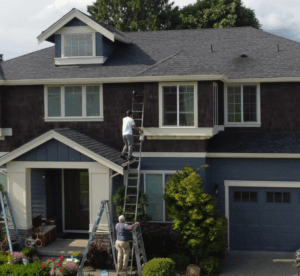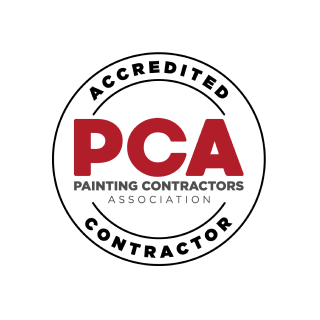Painting is a key element in maintaining and enhancing both residential and commercial properties across the Seattle area. The unique maritime climate of the Pacific Northwest presents specific challenges that demand thoughtful selection of paints and application techniques. The Pacific Northwest climate, with its mild temperatures, high humidity, and substantial rainfall, necessitates choosing the right paint to combat issues like mold and mildew. Understanding how different surfaces interact with Seattle’s weather patterns will help you make informed decisions for your painting projects.

Introduction to Exterior Painting
Exterior painting is a crucial aspect of maintaining a home’s exterior, providing protection from the elements and enhancing its aesthetic appeal. The Pacific Northwest’s unique climate, characterized by frequent rain, high humidity, and mild temperatures, demands careful consideration when selecting exterior paints. Homeowners must choose paints that can withstand the region’s weather conditions, ensuring a long-lasting finish and preventing issues like mold growth and peeling paint. Acrylic latex paints are a popular choice for exterior painting in the Pacific Northwest due to their water-resistance, breathability, and flexibility. These paints offer excellent durability and can adapt to the temperature fluctuations typical of Seattle’s climate, making them an ideal option for protecting your home’s exterior.
Painting Different Surfaces in Seattle’s Climate
Wood Surface Painting
Wood is prevalent in Seattle architecture, used for siding, decks, fences, and trim. Painting wood surfaces not only adds visual appeal but provides essential protection from our region’s unpredictable weather. For exteriors, select high-quality paints designed to withstand moisture and UV rays. We recommend priming bare wood surfaces before painting to improve adhesion and durability. A popular color choice for homes in natural settings is dark forest green, which complements woodsy backdrops and Colonial style architecture.
The best time to paint wood exteriors in Seattle is during the drier months (June-August) when temperatures range between 50-85°F and humidity stays below 85%. This timing allows proper curing and creates a protective barrier that stands up to our wet winters. Selecting the right exterior paint not only enhances the aesthetic appeal of your home but also ensures durability against local weather conditions.
Stucco and Masonry Painting
Many buildings in the Seattle area feature stucco or masonry exteriors that require specific paint types to accommodate their unique properties. Acrylic or elastomeric paints work well for these surfaces, offering the flexibility needed to withstand our region’s temperature variations and moisture levels. Incorporating earthy tones in the color palette can enhance the natural beauty of the Pacific Northwest, creating a seamless connection between homes and the lush environment.
These surfaces benefit from paints that can “breathe” while remaining water-resistant—a critical balance in our humid environment. Proper preparation, including thorough cleaning and repairs, is essential before application to prevent mildew growth and maintain the durability and appearance of painted surfaces.
Metal Surface Painting
Metal surfaces like railings, doors, and gutters need protection from rust and corrosion. Use high-quality metal primers and paints designed to resist the effects of rain and coastal air common in the Seattle area. For lasting results, remove any existing rust, apply a rust-inhibiting primer, and finish with a weather-resistant topcoat. A striking contrast can be achieved by using vibrant colors like lively red against more subdued earth-toned neutrals, enhancing the overall aesthetic of your home.
Colors for metal surfaces should complement your overall exterior palette while providing the protection these surfaces need in our climate. Opt for a Low Lustre or Satin finish over Flat paint, as these finishes are better suited to withstand harsh weather conditions, ultimately leading to improved durability and color retention.
Drywall and Plaster Painting
Interior walls and ceilings typically consist of drywall or plaster. Your paint choice depends on the desired finish and durability requirements. For high-traffic areas, select washable, stain-resistant formulations. Always prime the surface before painting to create a smooth, long-lasting finish.
In Seattle homes, where natural light can be limited during winter months, consider how colors will appear under both natural and artificial lighting conditions. The region’s gray skies contribute to a palette of soft grays, earthy neutrals, and muted tones that enhance the architecture of homes. Testing samples at different times of day helps you make the right selection. Neutral tones like taupe, beige, and muted cream create an earthy and grounded aesthetic, complementing darker trim colors for a cohesive look.
Concrete Floor Painting
Basements and garages often have concrete floors that benefit from specialized painting. Beyond aesthetics, painted concrete resists stains and damage. Epoxy floor paints provide durability, easy maintenance, and resistance to chemicals and moisture—important qualities in our damp climate. Additionally, choosing colors like ‘dusty blues’ can add a sophisticated and contemporary touch to your home exterior.
Proper floor preparation, including thorough cleaning and etching, creates the foundation for a successful concrete painting project that will resist Seattle’s moisture challenges and minimize surface imperfections.
Preparing Surfaces for Painting
Proper surface preparation is essential for a successful exterior painting project. This includes cleaning the surface to remove dirt, grime, and mildew, filling any cracks or holes, and sanding to create a smooth finish. Wood surfaces, such as wood siding, require special attention to ensure proper paint adhesion. This often involves scraping off old, peeling paint and applying a high-quality primer before painting. Stucco surfaces, on the other hand, need to be cleaned and repaired before painting to prevent paint from adhering unevenly. Elastomeric paint can be used on stucco surfaces to provide a flexible and waterproof seal, which is particularly beneficial in Seattle’s damp climate. It’s also important to consider the surrounding landscape and natural environment when preparing surfaces for painting, as this can influence the choice of paint colors and finishes.
Types of Paints for Seattle’s Various Surfaces
Exterior Paints
Seattle’s climate demands durable exterior paints that withstand constant exposure to rain, wind, and UV rays. High-quality acrylic latex paints work well for wood, stucco, and properly primed metal surfaces. These paints provide excellent coverage, color retention, and fade resistance, ensuring a long-lasting exterior. Selecting the right exterior paint is crucial for protecting homes in the unique climate of the Pacific Northwest.
For best results in our climate, look for paints with these key features:
- Moisture resistance to combat rain and humidity
- Flexibility to handle temperature shifts without cracking
- Mildew resistance for our damp environment
- UV protection even on cloudy days
Satin or low-lustre finishes tend to perform better in Seattle as they shed water more effectively than flat finishes. Additionally, choosing high-quality paint designed to resist fading will help maintain vibrant colors and better color retention under sun exposure.
Common Mistakes to Avoid
When it comes to exterior painting, there are several common mistakes to avoid. One of the most significant errors is not properly preparing the surface, which can lead to paint failure and a shortened lifespan. Another mistake is selecting the wrong paint for the surface, such as using oil-based paint on wood siding, which can lead to cracking and peeling. Additionally, not considering the local climate and weather conditions can result in paint that is not suitable for the region, leading to issues like mold growth and fading. Using low-quality brushes or rollers can also affect the paint job’s quality and durability. It’s essential to use high-quality brushes and proper tools to ensure a smooth and even finish. By avoiding these common mistakes, you can achieve a long-lasting and visually appealing exterior paint job.
Exterior Paint Maintenance and Repair
Regular maintenance and repair are crucial to extending the life of an exterior paint job. This includes inspecting the paint for signs of wear and tear, such as cracking or fading, and addressing any issues promptly. Cleaning the surface regularly can also help prevent dirt and grime from building up and damaging the paint. In the Pacific Northwest, it’s essential to be mindful of the region’s wet winters and dry summers, which can cause paint to fade or crack. Using a paint with high weather resistance can help mitigate these effects. Additionally, considering the unique climate and natural environment of the Pacific Northwest can help homeowners make informed decisions about exterior paint maintenance and repair. Regular touch-ups and timely repairs can significantly extend the life of your home’s exterior paint, ensuring it remains vibrant and protective for years to come.
Local Regulations and Codes
Homeowners in the Pacific Northwest must comply with local regulations and codes when it comes to exterior painting. This includes obtaining necessary permits, following environmental guidelines, and adhering to neighborhood covenants. In Seattle, for example, homeowners must comply with the city’s environmental regulations, which include using eco-friendly paints and minimizing waste. It’s essential to research and understand the local regulations and codes before starting an exterior painting project to avoid any potential issues or fines. Consulting with professional painters can help homeowners navigate these regulations and ensure a successful painting project. Professional painters are well-versed in local requirements and can provide valuable guidance on selecting the right paints and techniques to meet both aesthetic and regulatory standards.
Getting Started With Your Seattle Painting Project
The right preparation, paint selection, and application techniques make all the difference in Seattle’s unique climate. Timing is also crucial—the ideal painting window for exteriors is late spring through early fall (particularly June-August) when temperatures are moderate and humidity is lower. These conditions support proper curing and create a protective barrier that stands up to our wet winters. Choosing paint colors that enhance the natural appeal of your home can also make a significant difference, especially with moody, evergreen-inspired hues that reflect the deep, dense forests of the region.
Remember that proper exterior painting is more than simply applying a fresh coat of paint. Our approach involves thoroughly inspecting surfaces, identifying and treating damaged areas, and properly preparing every inch before beginning the paint application. We know that prep work is the most fundamental step of any exterior painting project—especially in Seattle’s challenging climate, where moisture can quickly compromise improperly prepared surfaces.
A quality paint job on any surface doesn’t just enhance visual appeal; it significantly increases your home’s value, protects against our harsh Pacific Northwest weather, prevents wood rot, blocks insects from entering small cracks, and creates lasting curb appeal. Most experts recommend refreshing exterior surfaces every several years, especially for homes with significant wood elements that need protection from our rainy climate.
Ready to rejuvenate your home or business with surface-specific painting expertise? Contact us today for a free estimate. Our professionals understand Seattle’s unique climate challenges and can guide you through selecting the right paints and techniques for each surface type. Whether you need wood siding refreshed, metal surfaces protected, or concrete floors sealed, we’ll help you achieve results that look beautiful and withstand our Pacific Northwest weather for years to come.









